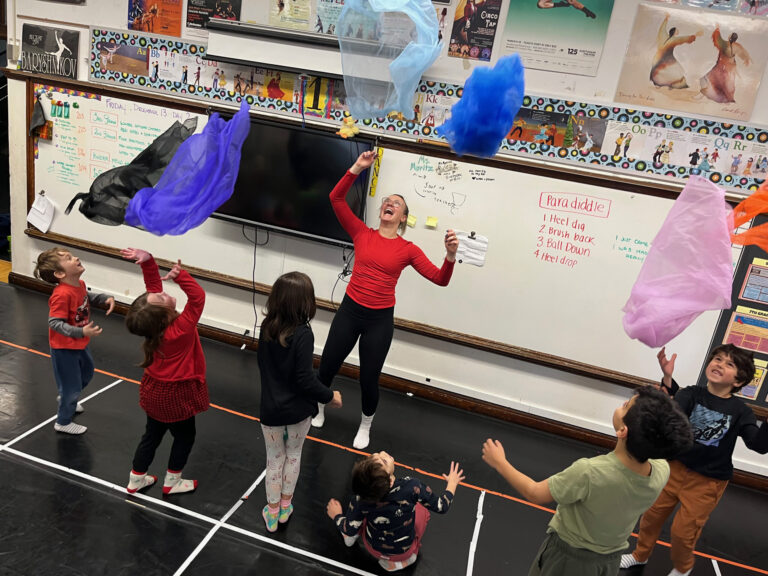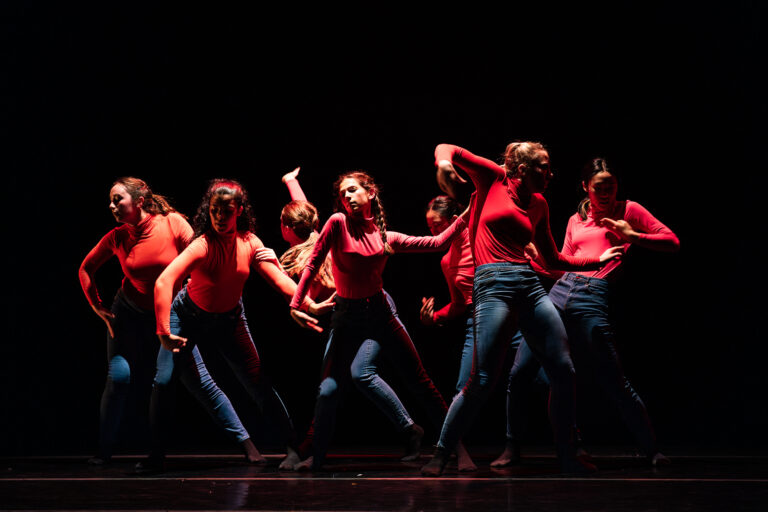University of Georgia professor Bala Sarasvati has dedicated the past 16 years to investigating aerial dance. So it may come as a surprise that it wasn’t a part of her extensive college and graduate training. But now, at UGA—where she’s been on faculty for 26 years—she’s made sure that it’s a part of her students’ education. As artistic director of the dance program’s performance company, Sarasvati has transformed what was a typical modern-based student troupe into a flourishing aerial dance company with a focus on multimedia collaboration.
A Soaring Start
The Athens-based university student company first began to explore aerial work in 1999, when Sarasvati purchased some bungee cords. She hung them from the ceiling and began to experiment with how the cords changed dancers’ relationship to gravity, momentum and dynamics. The result was a bungee-jumping piece—and an insatiable thirst for more aerial dance knowledge. When fellow aerial artist Susan Murphy introduced her to the trapeze a year later, Sarasvati was hooked.
Since she didn’t have experience with the various apparatuses, she brought in experts, like Elsie Smith of Cirque du Soleil. “Anytime we would do a new advanced skill, I’d bring in a professional to oversee it, because we have them locally,” says Sarasvati, referencing the growing number of circus art practitioners in the greater Atlanta area. She gradually added new equipment every few years, partly funded by her own research endowment. Today, students can try any one of six different types of aerial work: trapeze, triple trapeze, silks, lyra, slings and bungees.
Although there is no curricular requirement to take aerial dance, UGA students who are a part of the company receive credit hours toward their BFAs. “They’re doing intense studio practice and performing,” she says. “And many of them have performed in New York and internationally.” Sarasvati took the company on a performance tour to China in 2005, and in 2008, she took a group to Liverpool to study aerial bungee.
A Different Kind of Aerial
Where UGA differs from other aerial arts college programs is its emphasis on dance, rather than acrobatics. “Other programs have started opening themselves up to more circus art, whereas this stays more within the arena of dance,” says Sarasvati. “The circus arts are more skill-based and attract a broader range of people.”
Sarasvati is certified in Laban Movement Analysis, and her work reflects that influence. Her aerial choreography, for instance, takes place much lower to the ground. “It’s about how to move on and off the floor,” she says. “I can remember being on the floor in the studios in New York for hours and hours every day. For me, there was a natural evolution that took the idea of level change into the air.” In her aerial choreography, Sarasvati remains mindful of traditional elements of composition like phrasing, shape, flow and transition, especially when getting on and off the equipment. “It truly is a form of aerial dance that is an extension from the ground into the air,” she says.
Sarasvati coaches a student on silks. Photo by Jacquelyn Kibbe, courtesy of Sarasvati
New Heights
Something else that sets Sarasvati’s aerial approach apart is her collaboration with other university departments to create multimedia aerial productions. For one of her earliest works at UGA, she worked with the school of ecology to create Forest Dreams, a piece about the rain forest.
Her most recent multimedia collaboration was with UGA astronomy and physics professors: DAAP Stellar and the Dream Chasers! Original student-created animation was projected on 20-foot weather balloons alongside dancers performing with silks, a bungee, a lyra and a triple trapeze. The projections showed famous scientists and explained scientific facts about physics and astronomy.
One of the challenges of aerial work, Sarasvati admits, is simply showing it. Most performance spaces don’t have the necessary provisions for aerial rigging. “A lot of people don’t even realize what we’ve been doing, because hardly any venues will take it,” she says.
Sarasvati hopes to keep finding new ways to present aerial dance in conjunction with other mediums. “It’s not a Cirque du Soleil kind of model. It’s not a 21st-century-dance kind of model. It’s just a new model,” she says. “I envision moving out of a concert stage and into a different kind of arena that is suitable for larger audiences. I love the idea of bringing together the arts, science and technology all into one idea.” DT





